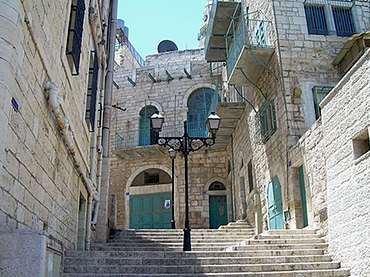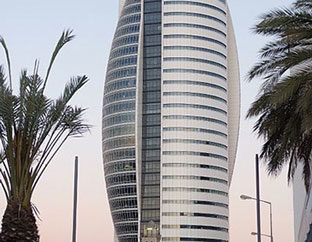Bethlehem

(Photo: Calivoro, CC BY-SA 3.0)
Street in New Bethlehem
City of Bethlehem
Bethlehem, located just south of Jerusalem, was first mentioned in the Bible as the burial place for Jacob’s (Yaakov’s) beloved wife, Rachel, who died after giving birth to their second son, Benjamin. Her tomb, known to locals as Kever Rachel, can be visited there today.Located in the area allotted to the tribe of Judah, or Yehuda, Bethlehem is where King David, the great grandson of Boaz of Bethlehem and Ruth the Moabitess (who converted to Judaism) was born and crowned.
According to the Gospels, The Christian Savior was also born in Bethlehem to Mary and Joseph, in a manger surrounded by peaceful animals, as there was no room in the inn. They had come to Bethlehem in Judea to be registered in a census carried out by the occupying Romans.
Different denominations celebrate the birth on different dates, so Bethlehem has a long holiday season – from December 24 to the middle of January.
Bethlehem’s very close proximity to Jerusalem makes it possible to tour there as part of a wider Christian tour to sites in Jerusalem and the Galilee. While you can go there on your own, you can also use an experienced tour guide. Be sure to dress modestly when visiting Bethlehem and women should have a kerchief or shawl to cover their hair when visiting Roman Catholic churches.
- B
- adriatikus CC BY-SA 3.0
Manger Square
The Church of the Nativity
Bethlehem’s most famous attraction is the Church of the Nativity, believed to be the oldest church in the world. The current Greek Orthodox Church in Manger Square was built over earlier churches, where some of the original mosaics can still be seen. The main altar leads to a cave reputed to be the manger where the baby was born. The exact spot of the birth is marked by a large star and this is called the Grotto of the Nativity.
The Catholic Church of St. Catherine is right next to the Church of the Nativity; there is also a Franciscan monastery there.
As you enter the church on the right, there are steps leading down to more caves under the Church of the Nativity. Some of these caves are tombs, including the burial place of St. Jerome, who came here from Italy and translated the Bible (Tanach) from Hebrew into Latin (the Vulgate). Until then, all translations had been made from the Greek Septuagint, but Jerome made his translation from the original Hebrew.
Milk Grotto
The Milk Grotto, also called the Grotto of the Lady Mary, is not far from Manger Square. This cave, made of milk-white chalk, is under a Franciscan chapel. It is believed that Joseph and Mary and their baby took refuge here from Herod before they escaped to Egypt, where they remained until the death of Herod, after which they returned to Nazareth in the Galilee of Israel.

Diego Delso CC BY-SA 3.0
Roman Catholic Church of Shepherds Field
Shepherds Fields
Several sites run by different denominations claim to be the original Shepherds Fields, where according to the Gospels shepherds heard the angel of the Lord announcing the birth. All are near the village of Bet Sahur, to the east of Bethlehem.
* The Protestant site is at the YMCA in Bet Sahur, where there is a cave and a pine grove.
* The Greek Orthodox site is at Kanisat al-Ruwat, where archaeological remains of a 4th century cave church can be viewed from the larger church built over it.
* The Franciscan Roman Catholic site is at Khirbat Siyar al-Ghanim, where there is a cave chapel and a modern church.
King David’s Wells or cisterns, called Biyar Daoud in Arabic, are three very old cisterns, believed to be those David wanted to drink from to quench his thirst after his fight against the Philistines. Today they can be viewed in the Catholic Action Club, near the entrance to the old main road in Bethlehem.
Bethlehem: Did You Know?
Did you know that in 2012, archeologists found a clay seal at Ir David in Jerusalem, with the word ‘Bethlehem’ on it, in Hebrew, establishing Bethlehem as a Jewish town at the time of the First Temple?








